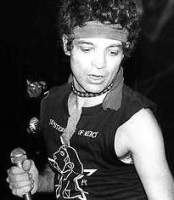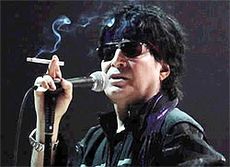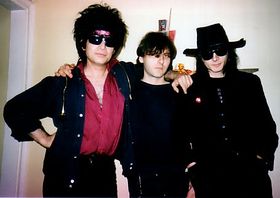Difference between revisions of "Alan Vega"
m (add ext link) |
m (+inf/pics) |
||
| Line 1: | Line 1: | ||
| − | Alan Vega (born 1948) is the vocalist for 1970s and 80s punk/post punk duo [http://en.wikipedia.org/wiki/Suicide_%28band%29 Suicide]. | + | [[File:Alan Vega.jpg|left|thumb|180px|Alan Vega]] |
| + | [[File:Alan Vega in more recent times.jpg|thumb|right|230px|Alan Vega in more recenct times]] | ||
| + | <br/> | ||
| + | '''''Alan Vega'''''' (born 1948) is the vocalist for 1970s and 80s punk/post punk duo [http://en.wikipedia.org/wiki/Suicide_%28band%29 Suicide]. <br/> | ||
| − | Alan Vega was born in Brooklyn, New York | + | Alan Vega's vocals are said to be influenced by [https://en.wikipedia.org/wiki/Elvis_Presley Elvis Presley] and [https://en.wikipedia.org/wiki/Rockabilly Rockabilly].<br/> |
| + | |||
| + | Vega was born in Brooklyn, New York and began his career as a [http://www.limbos.org/suicide/suicideva2.htm visual artist], gaining notoriety <br/> | ||
| + | |||
| + | for his "light sculptures". Eventually he opened his own lower Manhattan gallery space, which he <br/> | ||
| + | |||
| + | called The Project of Living Artists. The Project served as a stomping grounds for the likes of the <br/> | ||
| + | |||
| + | [https://en.wikipedia.org/wiki/New_York_Dolls New York Dolls], [https://en.wikipedia.org/wiki/Television_%28band%29 Television] and [https://en.wikipedia.org/wiki/Blondie_%28band%29 Blondie], as well as the 15-piece jazz group Reverend B.,<br/> | ||
| + | |||
| + | which featured a musician named [https://en.wikipedia.org/wiki/Martin_Rev Martin Rev] on electric piano. Soon, Vega and Rev formed <br/> | ||
| + | |||
| + | '''''[http://en.wikipedia.org/wiki/Suicide_%28band%29 Suicide]''''', whose minimalist, aggressive music — a fusion of Rev's ominous, repetitive keyboards <br/> | ||
| + | |||
| + | and Vega's rockabilly snarl — helped pave the way for the electronic artists of the future. Suicide disbanded in 1980, and both Vega and Rev<br/> | ||
| + | |||
| + | undertook solo careers. Vega's self-titled 1980 debut and his 1981 album, Collision Drive, continued to explore the fractured rockabilly identity<br/> | ||
| + | |||
| + | he had established in his earlier work. 1983's [https://en.wikipedia.org/wiki/Saturn_Strip Saturn Strip], produced by longtime fan [https://en.wikipedia.org/wiki/Ric_Ocasek Ric Ocasek], marked Vega's debut for Elektra Records; but his relationship with them <br/> | ||
| + | |||
| + | soured during production for 1985's Just a Million Dreams, and at one point the label even attempted to remove the singer from his own studio sessions. <br/> | ||
| + | |||
| + | For more information about Alan Vega's musical career see also his [http://www.discogs.com/artist/54918-Alan-Vega Discography @discogs] | ||
| + | and the page referring to him [https://en.wikipedia.org/wiki/Alan_Vega @wikipedia].<br/> | ||
| + | <br/> | ||
| + | [[File:Alan Vega Kevin Patrick Andrew Eldritch.jpg|left|280px|thumb|Alan Vega, New York DJ Kevin Patrick and Andrew Eldritch in the early 19080s]] | ||
| + | <br/> | ||
| + | [[Andrew Eldritch]] met Alan Vega in the early 1980s in New York. <br/> | ||
| + | |||
| + | From early 1983 on [[The Sisters of Mercy]] regularly covered the '''''Suicide''''' track '''''[[Ghostrider (song)|Ghostrider]]''''' | ||
| + | - mostly in medleys <br/> | ||
| + | |||
| + | with ''[[Sister Ray (song)|Sister Ray]]'' and/or ''[[Louie Louie]]'', which also appeard in the final gig of their ''[[First And Last And Always (album)|First And Last And Always]]'' line-up <br/> | ||
| + | |||
| + | at [[Tue, 18-Jun-1985|Royal Albert Hall]].<br/> | ||
| + | |||
| + | The song was last performed by [[The Sisters of Mercy]] in another medley during their final encores on 26 January 1998 <br/> | ||
| + | |||
| + | at [[Mon, 26-Jan-1998|Ancienne Belgique, Brussels, Belgium]].<br/> | ||
| + | <br/> | ||
| + | In 1986, [[Andrew Eldritch]] approached Alan Vega to collaborate with '''''[[The Sisterhood]]''''' on their album '''''[[Gift]]'''''', <br/> | ||
| + | |||
| + | where Vega quite likely featured as a member of the [[Gift#Band_-_Recording_Personnel|The Chorus Of Vengeance]].<br/> | ||
| + | |||
| + | <br/> | ||
| + | <br/> | ||
Revision as of 10:43, 18 July 2014
Alan Vega' (born 1948) is the vocalist for 1970s and 80s punk/post punk duo Suicide.
Alan Vega's vocals are said to be influenced by Elvis Presley and Rockabilly.
Vega was born in Brooklyn, New York and began his career as a visual artist, gaining notoriety
for his "light sculptures". Eventually he opened his own lower Manhattan gallery space, which he
called The Project of Living Artists. The Project served as a stomping grounds for the likes of the
New York Dolls, Television and Blondie, as well as the 15-piece jazz group Reverend B.,
which featured a musician named Martin Rev on electric piano. Soon, Vega and Rev formed
Suicide, whose minimalist, aggressive music — a fusion of Rev's ominous, repetitive keyboards
and Vega's rockabilly snarl — helped pave the way for the electronic artists of the future. Suicide disbanded in 1980, and both Vega and Rev
undertook solo careers. Vega's self-titled 1980 debut and his 1981 album, Collision Drive, continued to explore the fractured rockabilly identity
he had established in his earlier work. 1983's Saturn Strip, produced by longtime fan Ric Ocasek, marked Vega's debut for Elektra Records; but his relationship with them
soured during production for 1985's Just a Million Dreams, and at one point the label even attempted to remove the singer from his own studio sessions.
For more information about Alan Vega's musical career see also his Discography @discogs
and the page referring to him @wikipedia.
Andrew Eldritch met Alan Vega in the early 1980s in New York.
From early 1983 on The Sisters of Mercy regularly covered the Suicide track Ghostrider
- mostly in medleys
with Sister Ray and/or Louie Louie, which also appeard in the final gig of their First And Last And Always line-up
The song was last performed by The Sisters of Mercy in another medley during their final encores on 26 January 1998
at Ancienne Belgique, Brussels, Belgium.
In 1986, Andrew Eldritch approached Alan Vega to collaborate with The Sisterhood on their album Gift',
where Vega quite likely featured as a member of the The Chorus Of Vengeance.


